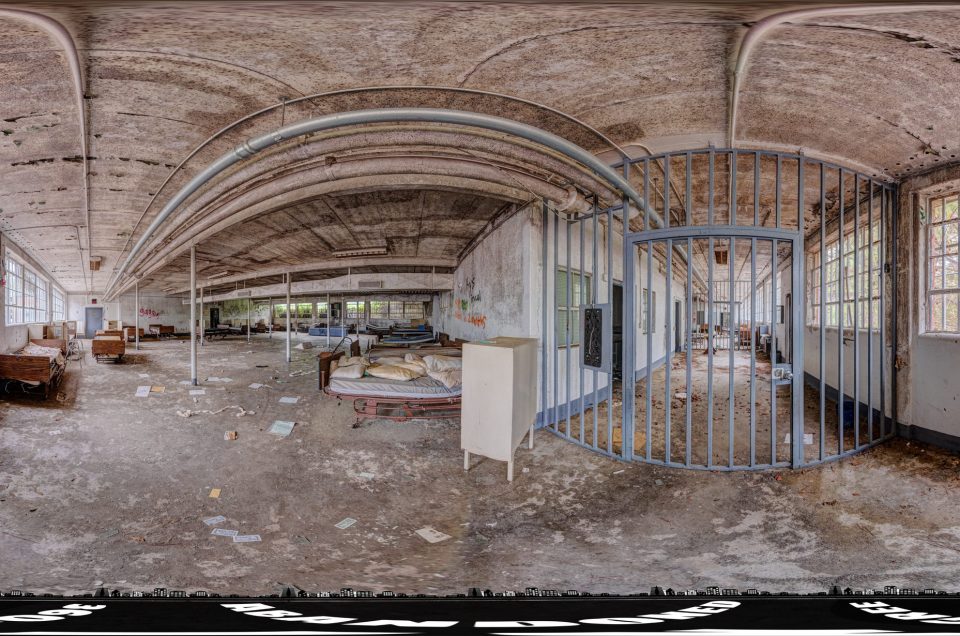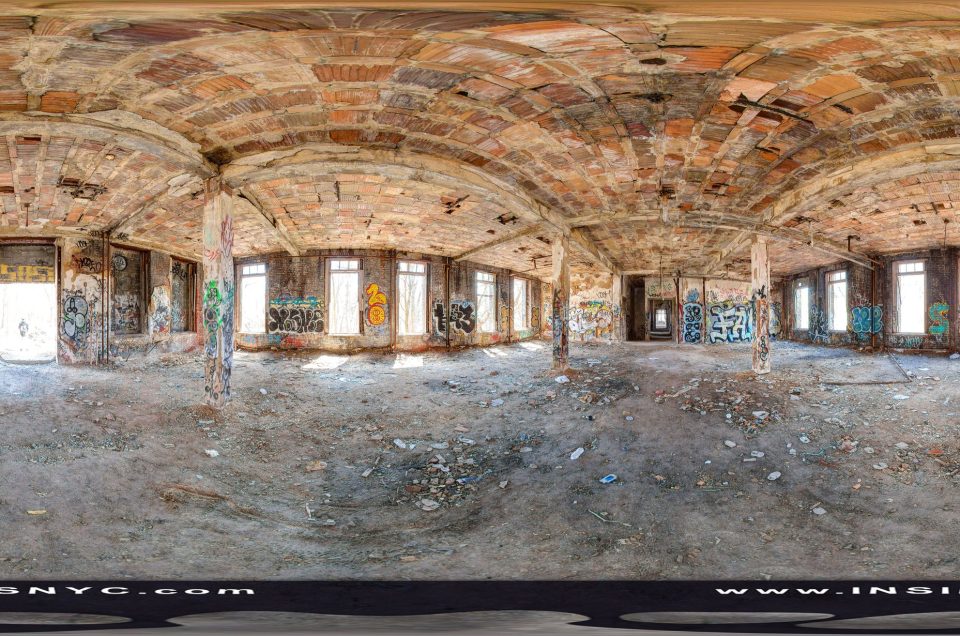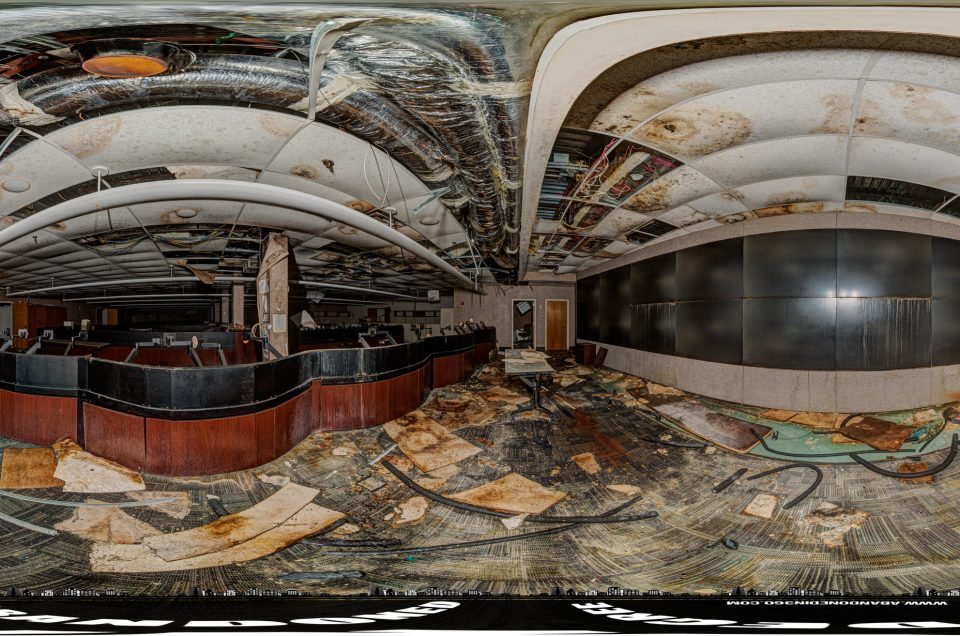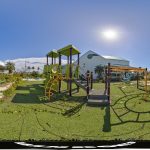Puerto Ferro Lighthouse: A Forgotten Beacon in Puerto Rico’s Wild Vieques
Step into the history of the Puerto Ferro Lighthouse and imagine the waves and wind that have battered its walls for generations. This coastal sentinel hints at maritime stories, structural details, and the quiet drama that draws urban explorers to places where time and the elements have done their work.
Ready to look around without setting foot on site? Take a look inside the Puerto Ferro Lighthouse building in Puerto Rico using the amazing 360-degree panoramic image below on Google Maps Street View, and study every weathered surface, corridor, and vantage point as if you were standing there yourself.
Photo by: Zahra Mohammadi
Standing lonely on a windswept bluff above the Caribbean, the Puerto Ferro Lighthouse is one of Puerto Rico’s most captivating ruins. Built by the Spanish in the late nineteenth century, this stout octagonal tower and attached keeper’s dwelling once guided ships through the treacherous Vieques Passage. Today its roofless walls and bramble‑filled rooms invite curious explorers to walk through time, feel the salt wind off the ocean, and imagine the life of keepers who tended the light before it went dark. This article takes you on an in‑depth journey through the history, architecture, and mystique of this forgotten beacon. We’ll explore how it was built, how long it operated, the reasons for its abandonment, and why it remains significant. If you’re an urban explorer or URBEX enthusiast looking for abandoned places in Puerto Rico, the Puerto Ferro Lighthouse deserves a place on your bucket list—but only if you’re prepared with the right knowledge and safety gear. Read on to discover its secrets.
The Historical Backdrop: Spain, Sugar and the Vieques Passage
Vieques in the Late 19th Century
Vieques, a small island off Puerto Rico’s southeast coast, was an agricultural outpost during the late 1800s. Sugar plantations dominated its economy, and merchant vessels carrying sugar, cattle and other goods regularly threaded the waters between mainland Puerto Rico and the Virgin Islands. Navigating the Vieques Passage was perilous because of reefs and shifting currents. In response, the Spanish colonial government embarked on a plan to build a network of coastal lights across Puerto Rico’s shores. Puerto Ferro Light—also known as Faro de Puerto Ferro—was part of this plan and one of the last minor or local lighthouses Spain would construct. Its purpose was simple yet vital: to illuminate the Vieques Passage and guide ships safely past the island’s rocky southern coastline.
Construction Delays and War
Spain began construction of Puerto Ferro Lighthouse in 1896. The design followed the neo‑classic style used at other small lighthouses on the island, with an octagonal stone tower rising from the center of a rectangular keeper’s dwelling. Workers quarried limestone locally and built thick masonry walls meant to withstand hurricanes and tropical heat. However, the Spanish–American War erupted in 1898, and Spanish forces were expelled from Puerto Rico. Construction halted as Spain ceded the island to the United States. When the U.S. Lighthouse Board took over, they reviewed the partially built structure and decided to complete it. Work resumed, and by December 1899 the lighthouse’s fifth‑order Fresnel lens was installed and the light was turned on. For the next quarter century, this little beacon would flash a white light every five seconds, visible for about twelve miles across the Vieques Passage.
A Day in the Life of Puerto Ferro Light
The Keepers and Their Duties
Puerto Ferro was classified as a minor or secondary lighthouse, designed to be manned by a single keeper and his family. Unlike major coastal lights with multiple keepers and assistants, life at Puerto Ferro was solitary. The keeper lived in the dwelling surrounding the tower and tended the lantern, polished the lens, wound the clockwork mechanism that rotated the optic, and maintained the cisterns and household. According to the U.S. Lighthouse Service records, Puerto Ferro’s lens was a fifth‑order Fresnel lens floating in mercury and driven by weights lowered down the stairwell. Every evening, the keeper would climb the tower, light the lamp and check that the mechanism turned smoothly. During the day he would paint, repair masonry, and care for the vegetable garden that provided fresh food.
Navigational Role and Local Commerce
The light was essential to local commerce. Merchants shipped sugar, cattle and other goods out of Vieques’s small ports. At a height of approximately 36 feet above ground—modest compared to major seacoast lights—the beacon’s white flash could be seen from all parts of the Vieques Passage. The alternating pattern of light and darkness told mariners they were approaching Puerto Ferro, which meant they could adjust course to avoid reefs and shallow waters. The lighthouse thus served as a navigational checkpoint for sailors heading east toward the Virgin Islands or west toward mainland Puerto Rico.
A Message in a Bottle and Everyday Curiosities
Life at Puerto Ferro may have been quiet, but occasional events broke the monotony. In 1912, the lighthouse keeper found a bottle washed ashore with a message inside. The note, thrown overboard by sailors, had traveled hundreds of miles before reaching Vieques. It must have been a delightful diversion for the keeper, who otherwise had few visitors. Although records are sparse, such anecdotes remind us that lighthouses were not just static structures; they were homes where people lived, worked and occasionally encountered the unexpected.
Architecture and Design: A Neo‑Classic Gem
Structural Layout
The Puerto Ferro Lighthouse is composed of a one‑story rectangular dwelling with an octagonal tower rising from the roof. According to the Historic American Engineering Record (HAER), the tower and dwelling were built from local stone and covered with stucco. A small vestibule provided access into the dwelling, which housed two bedrooms, a living room, an office, storage spaces, and a kitchen. Interior walls were thick masonry, and arched doorways separated rooms. The tower itself contained a narrow spiral staircase that led up to the lantern room. The original lantern, built of cast iron and glass, has disappeared—either lost during abandonment or dismantled by vandals—but early photographs show an octagonal lantern with a decorative balustrade.
Fresnel Lens and Lighting Technology
Fresnel lenses were the state‑of‑the‑art lighting technology in the nineteenth century, concentrating light beams into powerful flashes. Puerto Ferro’s fifth‑order lens produced a white flash every five seconds and had a range of about twelve nautical miles. The lens assembly floated on mercury to reduce friction, and a clockwork mechanism driven by descending weights rotated the lens. This system allowed the beam to sweep across the horizon at a constant rate, creating the characteristic flash pattern mariners relied upon. Because Puerto Ferro was a minor light, it used a smaller fifth‑order lens rather than the large first‑order lenses installed in major seacoast lighthouses.
Neo‑Classic Style
Architecturally, Puerto Ferro exemplifies the neo‑classic style adopted by the Spanish Lighthouse Commission for minor lights. The building has symmetrical facades, a flat roof, and minimal ornamentation, favoring function over decoration. The octagonal tower is integrated into the dwelling rather than standing separate—a practical design for small lighthouses. The overall appearance is both utilitarian and elegant, blending Mediterranean influences with Caribbean vernacular. It’s a testament to Spain’s careful planning and to the masons who carved and laid each stone by hand.
Operating Duration and Decline
Cracks in the Cliff
The lighthouse stood on a sea bluff subject to erosion and seismic activity. In 1913, inspectors noticed cracks forming in the tower and ground. They recommended relocating the light to a more secure location because the soil beneath was undermined and the structure had begun to deteriorate. The request was not acted upon, and the lighthouse continued to operate despite structural concerns. Over the next decade, earthquakes and coastal erosion worsened the damage. A strong earthquake in May 1922 cracked the tower and causeway; another earthquake in March 1925 dislodged the Fresnel lens. When the lens collapsed onto the floor, repairs were makeshift at best, and the light became unreliable.
Final Years and Abandonment
By 1925 the tower’s cracks had widened significantly. The keeper wrote to the Lighthouse Service reporting that the building was unsafe. In 1926 a severe earthquake further damaged the structure and dislodged the lens again. Authorities concluded that the site could no longer support a manned lighthouse. The Fresnel lens was removed, a skeletal steel tower with an automated beacon was erected nearby, and the original Puerto Ferro Light was abandoned. Thus ended almost thirty years of continuous operation—from its lighting in December 1899 until its deactivation in 1926. After abandonment, nature and neglect accelerated the decay. The roof collapsed, doors and windows disappeared, and the lantern, balustrade and other metalwork were scavenged. Graffiti and vandalism added to the ruin, leaving a roofless shell open to the elements.
World War II and the Navy’s Occupation
The story of Puerto Ferro does not end with its abandonment. During World War II, the United States Navy expropriated roughly two‑thirds of Vieques for use as an extension to the Roosevelt Roads Naval Station. The area around the lighthouse became part of a large bombing range and military training site. The Navy used the island for live‑fire exercises for decades. Residents were forced to relocate, and access to much of Vieques was restricted. Protesters opposed this use, especially after a 1999 incident in which a stray bomb killed a civilian guard. Persistent protests eventually persuaded the U.S. government to cease bombing activities and close the naval base in 2003. After the Navy withdrew, land containing the Puerto Ferro Lighthouse was transferred to the U.S. Fish and Wildlife Service and incorporated into the Vieques National Wildlife Refuge.
Urban Exploring in Puerto Rico: Why Puerto Ferro Lighthouse Matters
A Rare Example of an Abandoned Lighthouse
Urban exploring in Puerto Rico is growing in popularity as adventurers seek sites where history and decay intertwine. Puerto Ferro Lighthouse is one of the few abandoned lighthouses in the region that is relatively accessible and safe to visit. Most other lighthouses on the island are still active, restored or converted into museums. By contrast, Puerto Ferro remains essentially untouched since it was boarded up in 1926. Its remote location within a wildlife refuge adds to its appeal: the journey along a rough gravel road, the quiet of the coastal scrub, and the sudden appearance of a crumbling stone building evoke a sense of discovery. Urbex photographers will appreciate the interplay of light and shadow in its arched doorways and the textures of weathered masonry.
The Allure of Decay and History
What draws urban explorers to abandoned places? Part of the appeal is the opportunity to witness history in a raw, uncurated form. At Puerto Ferro, you can see how the jungle creeps into manmade spaces, how salt air eats away at mortar, and how time transforms an engineered structure into a ruin. Each cracked wall and collapsed roof tells a story. When you stand atop the foundation of the missing lantern and look across the turquoise sea, you can almost hear the voices of keepers who once carried oil up the stairs, children who played in the courtyard, and sailors who scanned the horizon for the beacon’s flash. This sensory immersion is what URBEX is all about—it’s a form of exploration that combines history, architecture, photography and adventure.
Respecting the Site and Its History
It’s essential to treat Puerto Ferro with respect. The building is fragile, and any further vandalism could cause irreversible damage. Do not remove artifacts or graffiti the walls. Instead, focus on documenting the site and appreciating its history. Because the lighthouse lies within the Vieques National Wildlife Refuge, visitors must follow refuge regulations, stay on designated paths, and avoid disturbing the surrounding ecosystem. Urban explorers should see themselves as stewards rather than takers. By sharing photographs and stories responsibly, you help raise awareness of the site’s cultural value and strengthen arguments for preservation.
Safety Tips for Exploring Puerto Ferro Lighthouse
Urban exploration is exciting but comes with risks. Puerto Ferro Lighthouse has been abandoned for nearly a century; its structural integrity is compromised. Here are safety guidelines to ensure a responsible adventure:
-
Travel with a Companion: Never explore alone. If you slip, fall or have a medical emergency, a partner can help or call for assistance. Cell reception can be spotty inside the wildlife refuge.
-
Wear Appropriate Footwear: The ground around the lighthouse is uneven and rocky. Wear sturdy hiking boots with good ankle support. Avoid sandals or open‑toe shoes, which offer little protection.
-
Bring Protective Gear: Wear a hard hat or climbing helmet to guard against falling debris when entering roofless rooms. Gloves can protect your hands from sharp edges and rough surfaces. Consider bringing a dust mask, especially if exploring interiors where collapsed plaster and bird droppings may be present.
-
Watch Your Step: Inside the dwelling, floors may be uneven or absent in places. Avoid climbing on walls or the remains of the tower. Do not attempt to access the roof—the structural supports are weakened.
-
Respect Wildlife: The refuge protects many species of birds, reptiles and small mammals. Do not disturb nesting sites or feed animals. Stay on the trail to minimize impact on native plants.
-
Be Weather Aware: Vieques can experience sudden rain showers. Bring water, a hat and sun protection. Check the forecast before your trip, and avoid exploring during or after heavy rain, which can make paths slippery and increase the risk of collapsing walls.
-
Carry a Flashlight: Even during the day, some rooms are dark, especially the tower base. A flashlight or headlamp helps you see hazards and appreciate architectural details.
-
Inform Others: Tell someone outside your group where you are going and when you expect to return. Because the site is remote, an emergency contact can alert authorities if you don’t check in.
-
Take Only Pictures: Leave the site as you found it. Avoid removing souvenirs or climbing onto delicate features. The best way to honor this ruin is to document it and share its story while preserving it for others.
-
Follow Refuge Rules: The Vieques National Wildlife Refuge has specific visiting hours and prohibited areas. Respect signs and closures. Rangers may patrol the area, and ignoring regulations can result in fines or expulsion.
Recommended Gear for URBEX Adventures
Urban exploring requires specialized equipment to navigate ruins safely and capture memorable images. When visiting Puerto Ferro Lighthouse and other abandoned sites, consider packing the following gear:
-
Sturdy Backpack: A durable pack with multiple compartments helps organize gear and keeps your hands free for climbing and photography.
-
Camera Equipment: Bring a camera with adjustable settings and a wide‑angle lens to capture the building’s interior and exterior. A tripod helps in low‑light situations. Extra batteries and memory cards are essential.
-
Headlamp and Flashlight: A headlamp provides hands‑free illumination, while a handheld flashlight gives directional light and reveals details in dark corners.
-
Protective Clothing: Wear long sleeves and pants to protect against scratches and insect bites. A lightweight jacket can shield you from rain and sun.
-
First Aid Kit: Include bandages, antiseptic wipes, tweezers and any personal medications. Small injuries like cuts or splinters can occur when navigating ruins.
-
Water and Snacks: The nearest amenities are far from the lighthouse. Bring enough water to stay hydrated and snacks to maintain energy, especially if hiking in the heat.
-
Gloves: Durable gloves protect hands when climbing or touching rough surfaces. Leather or reinforced work gloves offer good dexterity and protection.
-
Hard Hat or Helmet: A climbing helmet protects your head from falling debris. This is especially important in abandoned buildings with deteriorating ceilings.
-
GPS or Offline Map: Since cell service may be unreliable, having a GPS device or offline map ensures you can navigate the refuge trails. A compass is also a good backup.
-
Portable Charger: A solar or battery pack keeps your phone and camera charged. In remote areas, losing battery power can be more than an inconvenience.
Puerto Ferro Lighthouse in Context: Comparing Other Abandoned Sites in Puerto Rico
Urban explorers sometimes compare Puerto Ferro to other ruins across Puerto Rico. While there are numerous abandoned sugar mills, plantations and military installations, very few abandoned lighthouses exist. Punta Tuna and Punta Mulas lighthouses, built around the same period, were restored and are still functioning or preserved as museums. The Arroyo and Ponce lights are also maintained. Puerto Ferro stands out because it has not been reconstructed; its lantern is gone, its roof collapsed, and its walls weathered. It offers a raw, authentic ruin that is rare in a region where many historical structures have been repurposed or demolished. For URBEX seekers, this authenticity is a major draw.
Other notable abandoned or semi‑abandoned sites include the former U.S. Navy bunkers at Camp García in Vieques, the Central Azucarera Aguirre sugar mill near Salinas, and the ruins of the Solvay Carbon Co. at Playa Jobos. Each offers unique challenges and stories, but none match the blend of maritime history and scenic coastal location that Puerto Ferro provides. By visiting multiple sites, explorers can gain a broader appreciation of Puerto Rico’s industrial, military and colonial heritage.
Potential for Preservation and Interpretation
Puerto Ferro Lighthouse is part of the Vieques National Wildlife Refuge, managed by the U.S. Fish and Wildlife Service. As of now, there are no funded plans for restoration. The building is open to the public and accessible via a gravel road, but the lack of interpretive signage or safety improvements leaves its future uncertain. Some heritage advocates argue that stabilizing the structure, adding interpretive panels, and perhaps installing a replica lantern could make Puerto Ferro a more informative attraction. Others caution that any intervention may compromise its authenticity. The site’s inclusion on the National Register of Historic Places (as part of the HAER documentation) underscores its significance and could be leveraged for preservation funding. Still, resources are limited, and the remote location complicates maintenance. Urban explorers can contribute by raising awareness, sharing photographs, and advocating for responsible preservation.
Conclusion: A Beacon for the Adventurous
Puerto Ferro Lighthouse is more than just an abandoned building. It’s a time capsule of colonial ambition, maritime commerce, and military occupation. Built by the Spanish in 1896, completed by the U.S. Lighthouse Service and abandoned in 1926, it embodies a turbulent period in Puerto Rican history. Its design reflects the neo‑classic style of minor lighthouses, while its ruin speaks to the relentless forces of nature and neglect. For urban explorers, it offers an unparalleled opportunity to step into the past and experience a site where human endeavour and natural decay intersect. The adventure of reaching the lighthouse, the thrill of exploring its crumbling rooms, and the panoramic views of the Caribbean make it a highlight of URBEX in Puerto Rico.
As you plan your visit, remember that the lighthouse is both fragile and culturally significant. Approach it with respect, follow safety protocols, and leave no trace. If you document your adventure, share it to inspire others and advocate for preservation. In doing so, you help ensure that the Puerto Ferro Lighthouse remains a beacon—not of light, but of memory—for generations to come. And when you stand on the bluff as the sun sets over the Vieques Passage, perhaps you’ll sense the ghostly flicker of its long‑extinguished beam guiding your imagination toward stories yet to be told.
If you liked this blog post, you might be interested in learning about the abandoned Washington Building at Men’s State Prison in Milledgeville, the River Dyeing and Finishing building in Asheville, or the Abandoned Real Estate Office in Central Florida.
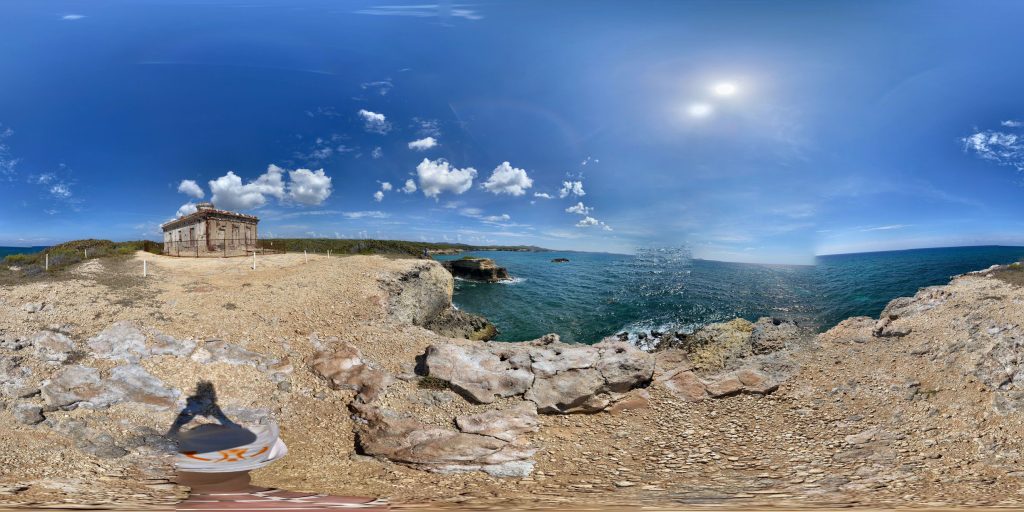
A 360-degree panoramic image at the abandoned Puerto Ferro Lighthouse in Puerto Ferro, Puerto Rico. Photo by Zahra Mohammadi
Welcome to a world of exploration and intrigue at Abandoned in 360, where adventure awaits with our exclusive membership options. Dive into the mysteries of forgotten places with our Gold Membership, offering access to GPS coordinates to thousands of abandoned locations worldwide. For those seeking a deeper immersion, our Platinum Membership goes beyond the map, providing members with exclusive photos and captivating 3D virtual walkthroughs of these remarkable sites. Discover hidden histories and untold stories as we continually expand our map with new locations each month. Embark on your journey today and uncover the secrets of the past like never before. Join us and start exploring with Abandoned in 360.
Do you have 360-degree panoramic images captured in an abandoned location? Send your images to Abandonedin360@gmail.com. If you choose to go out and do some urban exploring in your town, here are some safety tips before you head out on your Urbex adventure. If you want to start shooting 360-degree panoramic images, you might want to look onto one-click 360-degree action cameras.
Click on a state below and explore the top abandoned places for urban exploring in that state.
